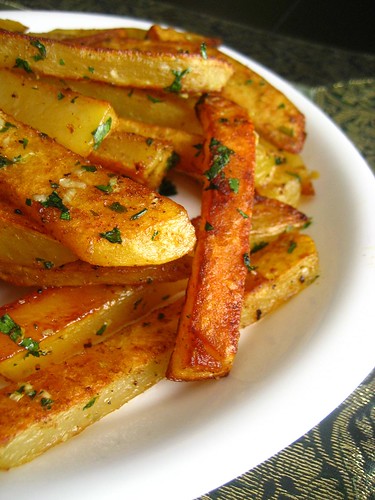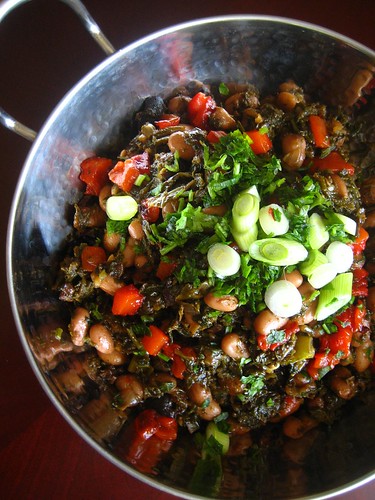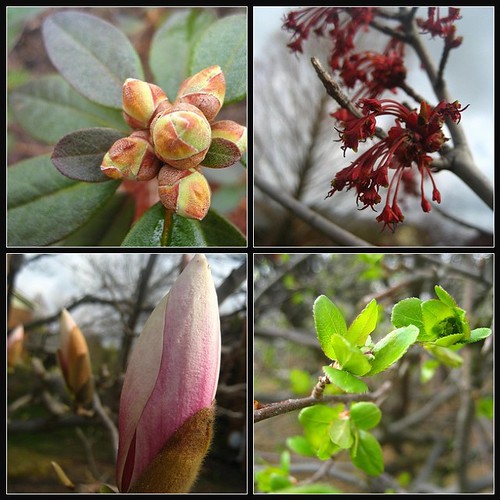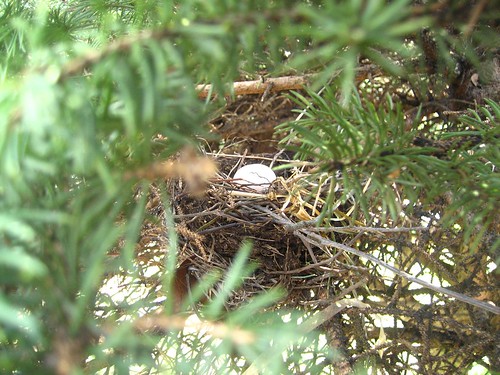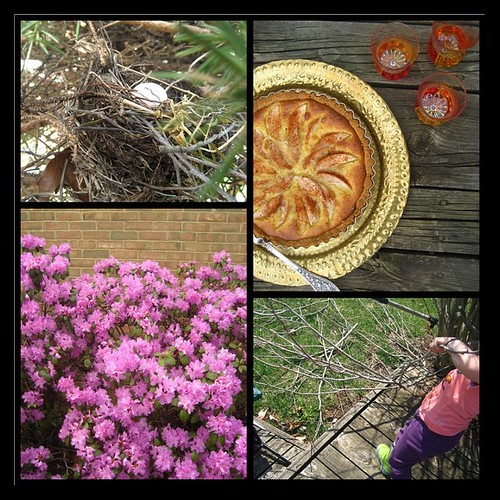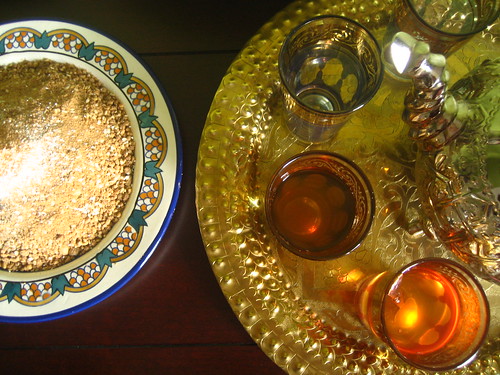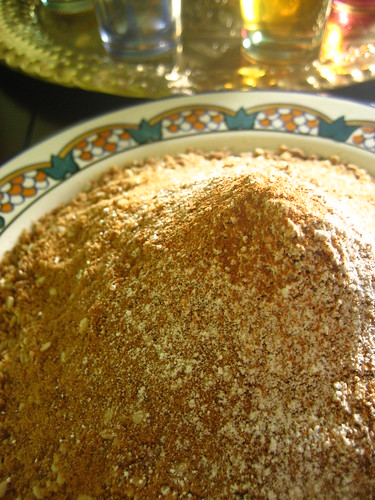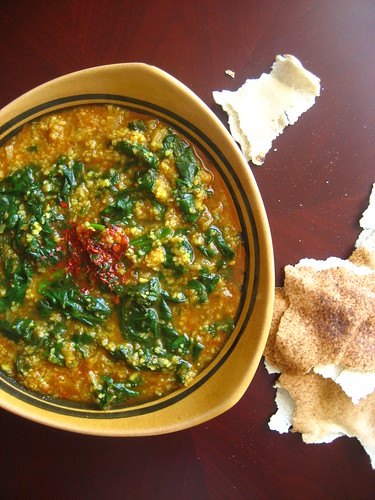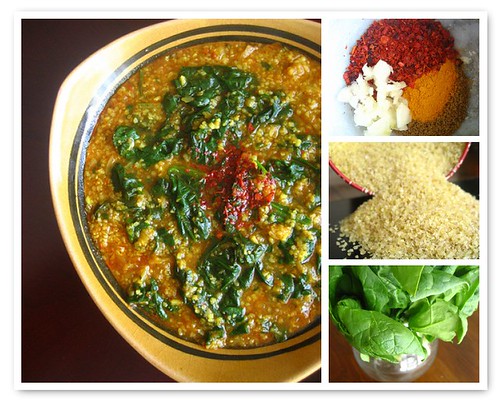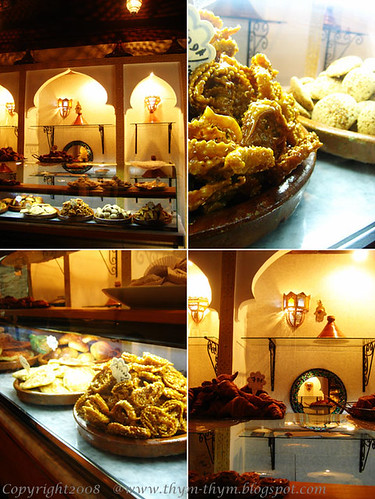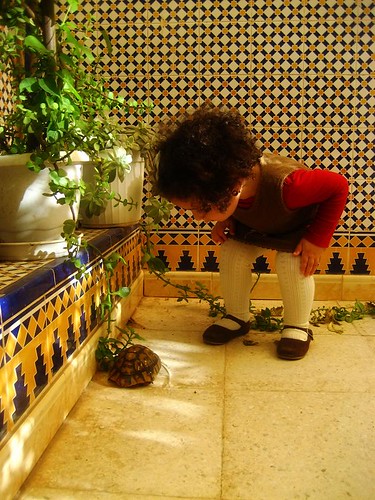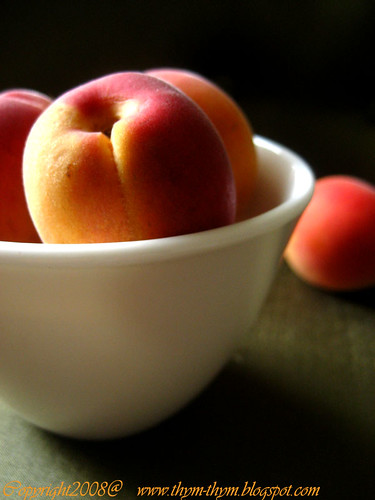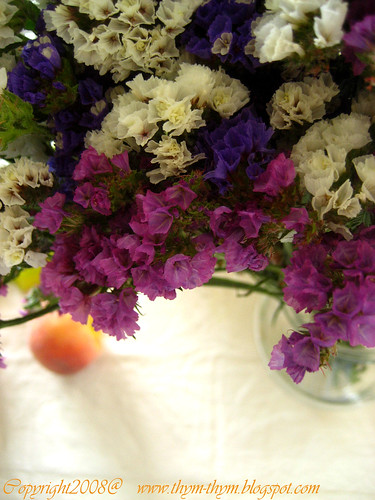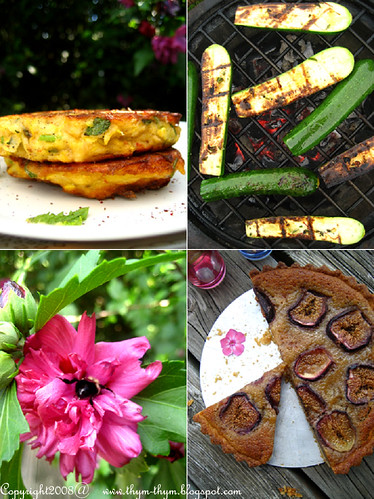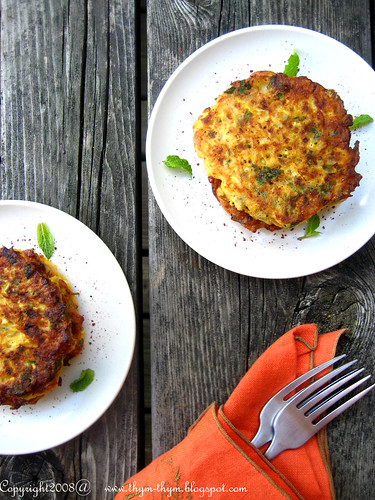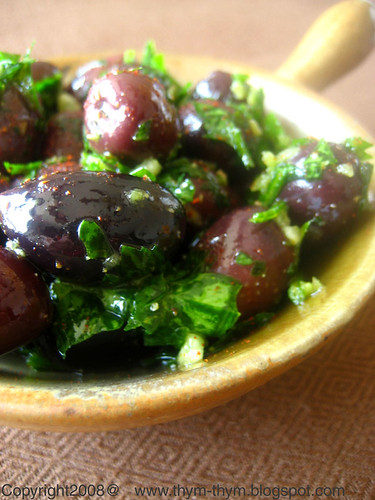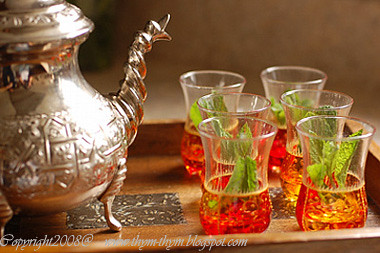Monday, October 24, 2011
Algerian Pastries in Ann Arbor
Three months ago, I decided to take the plunge and follow one of my dearest dreams. That week, butter, flour and orange blossom water spent most of the day on the countertop and my hands were rolling, shaping and filling pastries almost every single day. That week, Wednesday came faster than ever before and I’ve found myself one Wednesday afternoon packing my car with a table, a chair, a cardboard sign and a bin filled with pastries. With a kiss on the forehead from my husband and a hug goodbye from my daughter Layla, I backed up on the driveway and took the road that would get me closer to the Ann Arbor farmer’s market, to my dream; the road that would give birth to Al Meida fine Algerian pastries. That day, I gave birth to a slice of my country in the heart of Ann Arbor and it never felt so beautiful, so sweet, just like pastries.
Monday, August 22, 2011
Algerian Baked Fish
Today I came with the intention of telling you about the reason that made me disappear from my blog and fills most of my days, and my heart, with joy, perfumes of orange blossom water and so much bliss. (No, it’s not another baby!) But then, on Saturday, I baked these cute Sea Bass pictured above and they were so amazing, so lip-smacking delicious that I had to tell you about the fish and leave my life for later.
Monday, June 13, 2011
Meatballs and peas Tagine with asparagus and eggs
I should have called this dish: compromise peas; finding the middle ground peas.
A warm spring day, about seven years ago, back when I was a new bride with smoother hair, smaller waist and nonexistent squeaky toys in my living room, Mohamed and I came home from the farmer's market with a bag full of fresh green peas for dinner. He made mint tea for both of us and we took the bowl of green peas to our then tiny, but beloved, balcony and started shelling. We shelled, he ate and I talked. It was the perfect harmony, the perfect start to a beautiful dinner and evening; until I went to the kitchen and cooked peas the way I always had them at my parent's house, which is in a hearty stew with meatballs and a touch of cream.
It was delicious, comforting; at least to me. He set the table, must have lit some candles (we don't have candles on the table anymore, as all our daughters want to do when they see them is either touch them, blow on them or sing happy birthday) put on some music, must have made his way to the living room table dancing (thank goodness he still dance. I love his moves and so do the girls) and sat down to see in front of him a pool of green-brownish peas with scattered meatballs swimming.
Tuesday, May 24, 2011
Hidden gems of Algerian cooking
A couple of days ago, my husband came back from a business trip to Europe and an agreeable, though extremely short, one to Algeria where he visited our family and feasted on some of our beloved, dearly missed dishes that we can’t find or have difficulties duplicating here in Michigan due to the lack of ingredients. While most of our cooking is based on spices, fresh seasonal vegetables and grains, most of them widely available in the US, some more regional recipes are based on local herbs, techniques and just the heritage of our cherished native country.
Mexicans have Mole and Algerians (mostly Eastern part of the country) have M’loukhiya. While all Mole preparations begin with chili peppers, M’loukhiya (which in Ancient Egypt means “for kings and nobles”) is made using the leaves of Jute, removed from the stem and ground to a fine powder. It is cooked with olive oil, lamb, beef or chicken, garlic, fresh bay leaves, dried mint leaves, ground caraway and coriander and other spices. While the meat and garlic and spices are cooking, jute powder is mixed with water or broth and slowly poured into the meat mixture. M’loukhiya simmers until it thickens to a smooth mole like sauce, between 5 to 7 hours. And though the smell can be quite strong and reminiscent to some people to Henna, it is simply exquisite, with complex flavor that only calls for a crusty French baguette and a hungry stomach. Algerian and Tunisian M’loukhiya is different from Egyptian and Middle Eastern M’loukhiya where they use a different variety and the whole leaves of Jute. I might see Indian stores if they have the same variety of Jute to recreate this recipe at home.
Thursday, March 10, 2011
Different fish, different chermoula
I've been thinking a lot about how I should introduce this recipe. Or if I should really call it a recipe as it is a recommendation, a spur-of-the-moment suggestion made by my mother-in-law more than a year ago while we were talking about fish, soups and the newly planted lavender in our front yard.
Chermoula is a bold, garlicky, spicy sauce and marinade used all over Algeria, Morocco and Tunisia to spice up not only fish and seafood, but also poultry, meat and vegetables. Though recipes differ from one cook to another, its base is usually a harmonious mixture of garlic, spices (usually cumin and sweet paprika), fresh herbs (cilantro or parsley) and acid (lemon juice or white vinegar). Some might add onions, others saffron, preserved lemons, cayenne peppers, or even nuts, in which case we are leaning more towards pesto. But just like pesto, the process is as easy as peel, measure, pound and enjoy. The result is a zesty pool where every fish would like to swim in and every one of your senses would enjoy.
And while the world does not need another chermoula recipe, these two versions, as my mother-in-law explains, are interesting in respecting the quality and variety of fish you are cooking. The spice infused chermoula complements the robust flesh of oily fish while the less conventional thyme and ginger chermoula balances the delicate flavor and texture of white fish without being overpowering.
Sunday, May 23, 2010
Sautéed Kale with Cumin and Smoked Paprika / Chou frisé sauté au cumin et paprika fumée
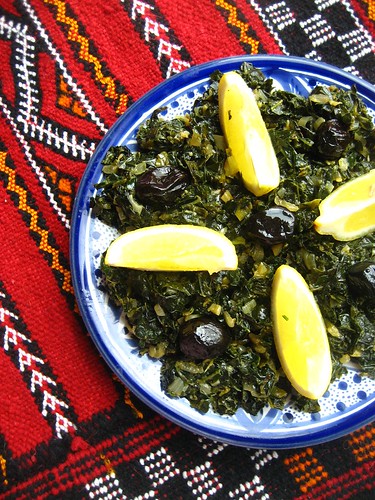
Now I have a confession to make. Until recently, the only reason I was buying kale was that somehow it made me feel healthier. Kale was my morning run, the responsible, and sometimes boring, part of me; my pretext for eating more of that mocha ice cream. Other than that, I thought Kale tasted bitter. It was OK, but nothing like my favorites: spinach and Swiss chards. And I’m not even talking about Mohammed’s opinion on the subject. The man rolls his eyes every time I reach for that Frizzy looking green at the market. I think that our aversion with Kale had something to do with my lack of confidence and ideas when cooking this intimidating green.
My mother often tells me this story about the woman who taught her how to turn any kind of greens into an exciting dish. This woman, her name was Ghazielle, which literally translates to little Gazelle. Ghazielle was by no mean petite. She was 6 feet tall, had strong shoulders, a suntanned face, from working in the fields all her childhood, and beautiful, dark kohl eyes. When she wasn’t looking after my younger brother, Ghazielle would sometimes make fresh bread for us. Bending over the gassa* (a large earth ware where you knead bread and make couscous) she would push and fold the dough back and forth until elastic and smooth. Her bread was, and still is, the best homemade bread I’ve ever had. It’s rustic, imperfect in appearance, humble, chewy and so flavorful.
Monday, February 22, 2010
Weeknights Potatoes / Les Potatoes de la Semaine
I'm slowly learning to juggle life with a second child, sleepless nights, milk scented clothes and one active toddler. It is not always easy. It is never the same. But at the end of the day, when I finally lay my head on the pillow, I am content. I am happy with my life, my family, my hectic days, my messy hair and the uncomplicated and unsophisticated, but always heartwarming, dishes I've been making lately.
We've been having these potatoes at least once a week for the last couple of weeks. They may not look like much. After all, they are just roasted potatoes sprinkled with herbs and garlic and some spices. Though I do believe that when equipped with a good potato specimen and the right amount and the right combination of spices, nothing beats Roasted spiced potatoes.
The recipe comes from my sister in law, who is a great cook and an even greater baker. What I like about this dish, besides being comforting and spicy and delicious, is that I can do it with my eyes half open. Perfect for my lethargic state these days. Peeling and slicing the potatoes is the only work you would do. The Potatoes basically cook themselves and the rest is chemistry between the herbs, the sharpness of the garlic, the freshness of the lemon and the warmth of the cumin, paprika and Harissa sauce. Perfect as a side dish with a roasted chicken or lamb.
Thursday, December 24, 2009
Chestnuts and Lamb Tagine / Tagine d'agneau aux châtaignes
Just like a burning fireplace, a snowy rooftop, a chilly morning buried underneath the warm sheets, no winter can be complete without roasted chestnuts or, for the less timid, luscious Chestnuts Tagine.
As I'm writing this, I know a lot of you are driving or flying to spend this time of year with your loved ones. You already have your holiday menu written down. Garland and lights are draped around the room. Fleece pajamas might be your only attire for the next days, and cookies and cakes might be crowding your kitchen.
But as the last burning wood fades away. As the last guest and the last crumb of cookies disappear, make yourself a warm cup of tea, turn on the stove again and try this tagine. It will feel like holidays all over again. Fleece pajama will still be welcome.
I usually use fresh chestnuts for this kind of tagine, but you can go for the canned ones if the idea of peeling all these shiny nuts before cooking them troubles you. The dish is savory, yet sweet at the same time. The lamb melts into the cinnamon and turmeric scented sauce until falling off the bone. The chestnuts, those succulent, fragile chestnuts with their soft interior, add another dimension to the whole tagine, slowly releasing their starch and their unique and sweet nutty flavor. It is a Tagine not to be missed.
Happy holidays, everybody!
Saturday, October 31, 2009
Algerian Lentil Soup / Soupe de Lentilles a l'Algérienne
If you would ask me about my favorite season, spring would be my first spur-of-the-moment answer. And it's not because my birthday is in spring and I love presents and birthday cakes and parties; though it has a lot to do. But it's spring when I and everything around feel alive again. When the tulips and daffodils shade our driveway. When the days are longer, and warmer and brighter. When small tomato plants start sprouting by the kitchen window and birds start building their nests underneath the deck.
It is spring that I love the most. That's what, five years ago, the girl from Algeria would have told you.
But then I came to Michigan, exactly five years ago, and I saw fall. Really saw it
And fall, oh fall, I've fallen for you!
I fall for you every morning from my window when I see the saffron colored trees and wiggly maple leaves sliding down the street. I smell your perfume and it smells like roasted chestnuts, burning fireplaces and wet soil. I touch you and you're warm and cold. I listen to you and you're quiet, untamed, stripping what's around you serenely.
At the farmer's market last week, I fell for your pumpkins and huggable squashes, and snow white leeks and swiss chards, and apple ciders and cute bees and supermen dressed babies . The babies weren't for sale, unfortunately!
Every year I find myself going back to my seasonal routines. Like making S'fendj (Algerian doughnuts) and hot chocolate for dinner, in the fall. Not that I wouldn't make them in the spring; I do. But it's different. It's fall when I really start to crave S'fendj and hot chocolate in the evening. I think it's because they are both comforting (always loved hot chocolate with my doughnut). It's fall when I listen to Damien Rice and Amos Lee. Fall when I can't wait to slip into my warm slippers in the morning and snuggle with my blue blanket in the evening watching brothers and sisters. It's fall when the 4PM snack time becomes mandatory, when I make upside down apple and fig yogurt cake, sweet rolls for breakfast, meat or meatless stews for lunch and drool over the beans selection at my local grocery store. It's fall when a spicy lentil soup, and a very good one for that matter, and some crusty bread, should never be missed.
Though there are as many lentil soup recipes as there are good cooks, this one has always been the one I rely on when I want a complex flavored yet rustic and authentic Algerian lentil soup. And did I mention how easy it is to make? In a snap! The soup combines my mother's beloved lentil stew recipe with the addition of Dersa, a mixture of spices, herbs and acid that is commonly used in Algerian households to finish up soups and add another dimension of fragrance and flavor to the dish. The recipe yields a lot of soup(I'm afraid I will never learn how to make soups and stews for just two or even four people) but can easily be halved. You can use any type of lentils you like, but for this specific recipe, and that's just me, I prefer the old fashioned brown lentil. As I love how it melts in your mouth and release a certain earthy, dare I say comforting note. Green lentils (also known as French lentils) wouldn't work here. I used lamb bones in my recipe, mainly for the aroma, and because we love our lamb in Algeria, but you can skip them and use homemade or very good quality chicken stock or vegetable stock instead. What makes this soup so irresistible and lip-smacking delicious is the combination of warm spices like turmeric, cumin and ground coriander with fresh herbs like mint, parsley and cilantro. And I mean a lot of cilantro. It is key here. Of course six cloves of garlic, four at the beginning and two with the Dersa, have also a lot to do, flavor wise. I believe this soup is going to be around for more falls to come. And winters, too.
Happy weekend, everybody!
Algerian Lentil Soup (Chorbet Addas)
Recipe: serves 6
- 1 cup lentils, picked over for stones and other debris, rinsed and drained
- 2 pounds lamb soup bones
- 2 tbsp canola oil
- 1 medium onion, chopped (about 1 cup)
- 2 big carrots, diced (about 1 cup)
- 2 celery stalks, diced (about 1/2 cup)
- 4 garlic cloves, minced
- 2 ripe, medium tomatoes, peeled and diced (about 1 1/2 cup)
- 1/2 tsp ground turmeric
- 1 tsp ground cumin
- 1 tsp ground coriander
- A bouquet garni, made of: 4 sprigs of parsley, 4 sprigs of cilantro, 4 sprigs of fresh mint and two bay leaves, tied together with a string
- 8 cups water (chicken or vegetable broth if you're not using the lamb bones)
- 2 tsp kosher salt
- 1/2 tsp freshly ground black pepper
- For the Dersa:
- A very generous bunch of cilantro chopped (about 3/4 cup)
- 1/2 tsp ground cumin
- 2 garlic cloves
- 1/2 tsp zest of a lemon
- 1 tsp lemon juice
- 1 tbsp good olive oil
Heat oil in heavy large saucepan over medium heat. Add onions, celery, carrots, cumin, ground coriander, turmeric and garlic; sauté until vegetables begin to brown slightly, about 10 minutes. Add 8 cups water, lamb bones, lentils, and tomatoes and bring to boil. Reduce heat to medium–low, cover, and simmer until lentils are tender, about 30-35 minutes.
Meanwhile, prepare Dersa. On a chopping board, mince the garlic cloves finely. Add the chopped cilantro, lemon zest and cumin and give it another chop with your knife. Gather with your knife and chop. Gather and chop until everything looks blended. Put the mixture into a bowl and add the lemon juice and olive oil. Stir quickly and set aside.
When the lentils are done, discard the bones and the herbs bundle. Season with more salt and pepper if needed and half the Dersa. Ladle soup into bowls. Garnish with remaining Dersa.
B'ssahatkoum! (To your health!)
Soupe de Lentilles a l'Algérienne (Chorbet Addas)
In Français Please: Pour 6 personnes
- 200g de lentilles, nettoyées et lavées
- 1 kg d'os d'agneau pour la soupe
- 2 c.s d'huile végétale
- 1 oignon moyen, finement haché (environ 250ml)
- 2 grosses carottes, coupées en des (environ 250ml)
- 2 céleri, coupés en des (environ 125ml)
- 4 gousses d'ail, émincées
- 2 tomates, bien mures, épluchées et coupées en des (environ 375ml)
- 1/2 c.c de curcuma
- 1 c.c de cumin en poudre
- 1 c.c de coriandre en poudre
- Un bouquet garni: 4 branches de persil, 4 branches de coriandre, 4 branches de menthe fraiche et deux feuilles de laurier, toutes attachées a l'aide d'une ficelle.
- 2L d'eau (bouillon de volaille ou de légumes si vous n'utilisez pas d'os)
- 2 c.c de sel
1/2 c.c de poivre noir fraichement moulu
Pour la Dersa:
- Un bouquet généreux de coriandre fraiche
- 1/2 c.c de cumin en poudre
- 2 gousses d'ail
- 1/2 c.c de zeste de citron
- 1c.c de jus de citron
- 1c.s d'huile d'olive
Faites chauffer l'huile dans une cocotte et ajouter, l'oignon haché, l'ail, carottes, céleri et épices; faites sauter jusqu'à une belle colorisation des légumes, environ 10 minutes. Ajouter 2L d'eau. les os d'agneau, lentilles, et les tomates et porter a ébullition. Réduire le feu, couvrir, et laisser mijoter jusqu'à ce que les lentilles deviennent tendres, environ 30-35 minutes.
Entre temps, préparer la Dersa. Sur une planche de travail, émincer l'ail finement. Ajouter la coriandre hachée, le zest de citron et le cumin et amalgamer le tout grossièrement a l'aide d'un couteau. Mettre le mélange d'herbe dans une assiette et ajouter le jus de citron et l'huile d'olive. Remuer rapidement et mettre de cote.
Quand les lentilles sont cuites, retirer les os et le bouquet garni. Assaisonner avec un peu plus de sel et de poivre si nécessaire et la moitie de la Dersa. Servir dans des bols et garnir avec le restant de Dersa.
B'ssahatkoum! (A votre sante!)
Thursday, April 30, 2009
A Mouthful of Spring / Une bouchée de Printemps
Though she seems to be all about cooking and stirring and baking, there were days where cooking was the last thing she wanted to do. Days where she couldn't stand spending more than an hour in front of the hungry stove, the piling dishes and the scratched cutting board. yes, there were days where she believed a sublime meal could come from a can of creamy pinto beans, some spices, a roasted red pepper and fresh, hearty Tuscan kale.
On those days, she enjoyed watching the blooming trees and flowers. Seeing the backyard flourishing, last year basil raising its tiny leaves from the dirt again and the hairy chives waving goodbye whenever the wind blows at the window.
She saw life nestled in a tree.
She saw life in the eyes of a little fairy.
She felt good walking barefoot in her house, on the grass, on the dirt, on the concrete. She smiled at the sight of her daughter throwing her little shoes and baring her naked feet to the warm sun while counting the bees.
She wore skirts and sandals. She curled her hair and opened wide her windows. She took a nap while a familiar breeze lifted the curtains to the ceiling tickling her toes and bringing back sweet memories.
She gave her family a helping hand when needed, a glass of tea when thirsty, a slice of tart when hungry. They all sat outside watching the sunset. Silent, they listened to the birds going to bed, the squirrels running up and down the trees. And the breeze. Always this familiar, sweet breeze.
On those days, near the river, the grass, the dirt, the blooming trees, she saw life. And it was beautiful.
I didn't have plans to make this dish, even less to post about it. I mean look at it! It doesn't look like from where you are: beans, herbs and bits of roasted pepper here and there. But the truth is, it has all what I was looking for on that warm spring day. In fact, I wish I had a can of pinto beans in my pantry right now so I can make it again today (note to self: buy pinto beans asap).
The dish is called Tbikha. In North Africa, especially in Algeria and Tunisia, Tbikha refers to a dish made with a combination of fresh and dry vegetables. Herbs are often added to the dish, as well as some heat like harissa or hot peppers. Peppers, squashes, carrots, turnips, cardoons and spinach are most often used, along with chickpeas and dried beans. The herbs are what makes this tbikha fresh, moist and bright. The creaminess of pinto beans, along with the delicate, slightly sweetness of kale and smokiness of roasted red peppers make it the perfect pair to a crusty bread. And may be some harissa coated olives…and why not some extra ground cumin to sprinkle liberally. Really, have a mouthful of spring this weekend. You will love it!
Tbikha Kale with Pinto beans and Roasted Red peppers
Recipe: Serves 4
- Two bunches of Tuscan Kale (or curly kale)
- 3 tbsp olive oil
- 1 can pinto beans, drained
- 1 medium onion, finely chopped
- 5 green onions, chopped
- 1/2 jalapeno pepper, finely chopped (or whole depending on your taste)
- 1 cup parsley, finely chopped
- 1 cup cilantro, finely chopped
- 3 garlic cloves, minced
- 1 tsp cumin, freshly ground
- 1/2 tsp sweet paprika
- Salt and freshly ground black pepper
- 1 red pepper, roasted, peeled and finely diced
- The juice of 1/2 lemon
Wash the kale and remove the stems. Chop roughly and set aside.
Pour the olive oil in a pan over a medium heat. Add the onions, cover and cook until translucent but not browned, stirring frequently. Add garlic, jalapeno pepper, cumin, paprika and herbs and cook for a few minutes until fragrant. Add the chopped kale, cover and cook until wilted and the leaves turn bright green. Season with salt and pepper. Add the beans, drained, and the roasted red pepper. Stir, cover and let cook for another 10 minutes for the flavors to infuse.
Serve in a plate drizzled with some good olive oil, the lemon juice and sprinkle with chopped coriander and green onion.
B'ssahatkoum (To your health!)
Tbikha le chou frisé aux haricot blancs et poivron rouge
In Français please: Pour 4 personne
- 2 bouquets de chou frisé (ou épinard ou blettes)
- 3 c.s d'huile d'olive
- 1 oignon moyen, finement haché
- 5 oignons verts, hachés
- 3 gousses d'ail, finement émincées
- 1/2 piment vert, finement haché
- 1 boite de haricots blancs, égouttés
- 200ml de persil haché
- 200ml de coriandre hachée
- 1 c.c de cumin, fraichement moulu
- 1/2 c.c de paprika
- Sel, poivre noir fraichement moulu
- 1 poivron rouge, rôti, épluché et coupe en petits dés
- le jus d'un demis citron pour finir
Laver le chou frisé et n'en garder que les feuilles. Couper grossièrement et mettre de côté.
Chauffer l'huile d'olive dans une poêle sur feu moyen. Ajouter les oignons, couvrir et laisser cuire jusqu'à ce qu'il deviennent transparents mais ne pas laisser caraméliser, en remuant fréquemment. Ajouter ail, piment vert, cumin, paprika et les herbes et laisser cuire pendant quelques minutes. Ajouter les feuilles de chou frisé, couvrir et cuire jusqu'à ce que les feuilles fondent et qu'elle aient une belle couleur verte. Assaisonner de sel, poivre noir. Ajouter les haricots blancs, égouttés, et le poivron rôti en petits dés. Remuer, couvrir et laisser encore sur un feu doux pendant 10 minutes.
Servir dans un plat avec un filet d'huile d'olive dessus, le jus d'un demis citron et quelques feuilles de coriandre et un oignon vert haché dessus.
B'ssahatkoum (A votre santé)
Thursday, March 26, 2009
Home-grown memories / Trésors faits-maison
I went silent, again, for more than a month. I had you starring at this spinach and bulgur thing for more than a month and I won't be surprised if you've gotten sick of it. Because I did. And so did all of the people I know.
The truth is the kitchen is still busy and I am still cooking and baking more than ever. The truth is whenever I make something and it turns out scrumptious and belly-rubbing-delicious and I want to tell you all about it, the camera seems to disappear. Then, I decide to make it again and it is even tastier than before and I take photos, download them to my computer, store them and at that moment the sun goes down, my sleepy eyes tell me I need my bed and before I knew it March is nearly over.
The truth is I love coming here and I miss it when I don't visit for a while. I love facing the white, smooth screen and thinking about what I'm going to write. I love my little kitchen journal, my childhood scented dishes, my home-grown memories.
The truth is I enjoy sharing my recipes with you all. I do it for you. I do it for me. I do it so I won't forget what should be remembered. I also do it for my daughter. My adorable Layla whom I love dearly. I do it for her because I want her to remember that harira was her favorite soup ever since she started solid food, and that one day she got her eye lids sticky because she got too much honey on her m'semmen, or how she loves the smell of couscous steaming and picking olives out of everybody's plate.
Because on her first day of school she can count on having her favorite homemade bread with butter and pooh's honey. Because her birthdays will always be filled with dark chocolate cakes, princess costumes and balloons. Because whenever she would need comfort a warm hug and a big kiss will always be there. Because I want her to know that her father loves making merguez for her and that he will always call her "my little girl" and I " my life". Because my days are sweeter when I she is here and that I miss her when she takes her nap. Because I want her to know that the day she will become a mother herself, I will put henna on her hands and her feet, will put kohl to her eyes, prepare a big bowl of berkoukes and a plate of sellou and I will give her more honey.
While sellou is rather complicated to categorize, it is considered in Algeria and Morocco as an energy paste, a traditional sweet often served at birth celebrations. It is basically flour that Is cooked in a dry skillet on the stove or roasted in the oven until nutty and golden. To that we add honey, melted butter, ground almonds, or any of your favorite nuts, ground anise seeds, ground cinnamon and sesame seeds. It is highly addictive, has a unique flavor and comes together in a snap. No eggs, no pan greasing, no baking. The flour may take some time before turning into a beautiful blonde shade, that's where a friend, a husband or the phone come in handy. Toddlers around the kitchen not obligatory but most welcomed, as they love the smell of roasted flour and cinnamon. And so do we.
Sellou (Fragrant Roasted Flour with nuts and honey)
Recipe: Serves 4-6 people
- 2 cups all-purpose flour
- 2 ounces sesame seeds, lightly toasted
- 4 ounces blanched almonds,or your favourite blend of nuts, ground
- 1 tbsp aniseed, freshly ground
- 1/2 tsp cinnamon, freshly ground
- 1 stick of butter, melted and cooled
- 1/4 cup honey
- Some icing sugar to decorate
In a dry skillet, on medium heat, cook the flour, stirring continuously until it turns a golden colour. Remove from the heat and transfer to a bowl.
Add to the flour the sesame seeds, ground or left whole, the almond meal, the aniseed and the cinnamon, and stir to combine. Add the melted butter and honey and stir first with a wooden spoon then with your hands to break any remaining lumps.
Mound the mixture in a pyramid on a plate. Dust with the icing sugar and decorate with some almonds or almond dragées.
Eat with teaspoons and serve with mint tea or coffee.
Sellou (farine torréfié au miel et amandes)
In Français please: pour 4-6 personnes
- 250g de farine
- 50g de graines de sésame, torréfié
- 100g d'amandes émondées et moulues
- 1 c.s de graines d'anis, fraichement moulues
- 1/2 c.c de cannelle, fraichement moulue
- 100g de beurre, fondu
- 100ml de miel
- Du sucre glace pour décorer
Dans une poêle, sur feu doux, faites cuire la farine en remuant constamment jusqu' a obtenir une belle couleur dorée. Retirer du feu et mettre dans un bol.
Ajouter a la farine les graines de sésame, moulues ou entières, les amandes moulues, l'anise en poudre et la cannelle. Remuer a l'aide d'une cuillère en bois. Verser le beurre fondu et le miel dessus et remuer d'abord avec la cuillère en bois, puis en vous servant de vos mains en frottant bien le mélange pour émietter tout grumeau restant.
Présenter le sellou en pyramide dans une assiette et décorer avec du sucre glace et des amandes entières ou des dragées si vous le souhaiter.
A déguster a l'aide de cuillères a café et servir avec du the a la menthe ou du café.
Wednesday, February 25, 2009
The Kitchen / La Cuisine
My trip to Algeria was about spending time with my family and friends, soaking up the sun, the blue sky and the sea; introducing my daughter to her origins, to my country, to my continent, to the place where her dad and I first met, to her cousins, her big and diverse family. Our trip was about love, fun and food.
We were six under the same roof. Every morning, my daughter would run down the stairs and into the kitchen to jump into my father's arms before sitting on his lap and take a sip from his coffee. My mother would already be wrapped in her apron doing important things like sweating some onions or dicing some vegetables. Breakfasts were toasts, caak, croissants, pastries, for the brave souls, which I am not, and m'semmen for special days and weekends. Mornings were laid-back, evenings were lingering with tea and sweets at 6PM and chocolate and dates at 12AM. My husband then joined us, followed by my sister, her husband and her three kids. We were then twelve under the same roof. There was no need to turn on the heating and no room to feel lonely. Some of us enjoyed spending time in the family room, others, like myself, snuggled in my parents bed watching cartoons with the kids. But the kitchen was where we all came together. It was in the kitchen where we laughed, argued, ate delicious meals, relaxed, danced, teased one another, where my daughter had her first earrings, where twice a week I ironed my father's shirts, where my sister nursed her one month old son, where my father reads his newspapers, where my husband had his first roasted lamb's tail and where I covered my eyes to avoid seeing such things as people eating lamb's tail.
But let's not talk about animal parts today. I'll leave it for later, for the brave souls. Today I want it to be special. As you have always been so nice to me, I want to share with you a recipe I should have told you about a while ago, as it is my favorite of all. I believe if I had one last meal, this dish would be on my table no doubt about it. This is my mother's spicy greens with bulgur.
Originally, the recipe calls for a variety of greens called khoubiz or bakool , which is found growing wild in the fields of North Africa. It tastes like a cross between arugula (rocket leaves) and watercress, with a hint of acidity, and there is no real equivalent for it here in the US. After experimenting, with fair results, with spinach, arugula, Tuscan kale, dandelion, I've had the best luck with the combination of spinach and arugula. It may not be much to look at, but when you have cumin, turmeric and red pepper flakes mingling with bulgur and spinach and arugula, the fusion is irresistible. Even for those who pretend detesting spinach, or any greens for that matter. (I have a friend who wouldn't eat anything with a green color and he absolutely loves this dish)
The spices and the cloves of garlic are pounded using a mortar and pestle to extract as much aroma before adding the resulting paste to the "sweaty" onions. As you pour the stock over the lovely ochre colored onions, restrain yourself from dipping your bread, or your fingers, as the sauce gets ready for the bulgur. At the end, steamed spinach and arugula join the party; a party that took half an hour to put together and will take half the time to gulp down. It's exquisite, I assure you. It's even exquisite the following day straight from the fridge, sitting on the countertop with a piece of bread in one hand and orange soda in the other. Every bite brings with it a part of home and my mother's kitchen into my own kitchen.
Thank you, mama!
My mother's Spicy Greens with Bulgur (Tchicha bel Khoubiz)
Recipe: Serves 4
- 2 tbsp extra virgin olive oil
- 1 medium onion, peeled and finely chopped
- 3 garlic cloves, peeled
- 1 tsp cumin, freshly ground
- 1 tsp red chili pepper flakes
- 1/4 tsp turmeric
-1 tbsp tomato paste
- 2 cups chicken or vegetable stock
- 2 tbsp fine bulgur
- 1 spinach bunch
- 1 arugula bunch
- 1 tbsp cilantro leaves, roughly chopped
- 1 tbsp parsley leaves, roughly chopped
- Salt, Black Pepper
Wash the spinach and arugula. Drain off the excess water and put them in the basket section of a steamer. Cover and steam over simmering water until the greens just start to wilt, but still have their vibrant green color, about 5 - 7 minutes. When cold to handle, squeeze the water out of the greens and chop roughly. Set aside.
In a pan, heat the olive oil. Add the onions and cook on a medium heat until translucent but not brown, about 5 minutes. Meanwhile, pound the garlic with turmeric, cumin, and pepper flakes to a paste using a mortar and pestle. Add the garlic paste to the onions and stir to incorporate. Add The tomato paste and the stock and bring to a boil. Add the bulgur and stir again. Lower the heat to a gentle simmer and cook covered until the bulgur is tender, about 15 minutes, depending on the variety of your bulgur.
Uncover the pan and add the steamed greens and the herbs to the sauce. Stir and cook for another 2 minutes and then remove from the heat. Season with salt and pepper and serve.
The dish keeps well in the fridge for up to 2 days, although I never recall keeping it longer than one day.
La recette épicée des épinards au bulghour de ma mère
In Français Please: Pour 4 personnes
- 2 c.s d'huile d'olive vierge
- 1 oignon moyen, finement haché
- 3 gousses d'ail
- 1 c.c de cumin, fraichement moulu
- 1 c.c de poivre rouge du chili
- 1/4 c.c de curcuma
- 1 c.s de tomate en conserve
- 2 c.s de boulghour
- 500ml de bouillon de volaille ou de légumes
- 1 bouquet d'épinard
- 1 bouquet de roquette
- 1 c.s de coriandre, grossièrement hachée
- 1 c.s de persil, grossièrement haché
Laver les épinards et la roquette. Essorer le plus de liquide possible et les faire cuire a la vapeur jusqu'à ce que les feuilles commencent a "fondre" mais tout en gardant leur belle couleur verte, environ 5-7 minutes. Essorer l''exces d'eau et hacher grossièrement les herbes. Mettre de cote.
Dans une poêle, chauffer l'huile d'olive. Ajouter l'oignon et laisser cuire jusqu'à ce qu'il devienne transparent, mais sans qu'il caramélise, environ 5 minutes. Entre temps, a l'aide d'un mortier réduire les gousses d'ail et les épices en une pate. L'ajouter aux oignons et tourner a l'aide d'une cuillère en bois. Ajouter la tomate en conserve et le bouillon. Porter a ébullition puis verser les graines de bourghoul en pluie sur le bouillon. Réduire le feu, couvrir la poêle et laisser les graines cuire, environ 15 minutes. Découvrir la poêle et ajouter les épinards, roquette, persil et coriandre. Remuer encore avec la cuillère en bois et donner un autre bouillon avant de retirer du feu, environ deux minutes. Gouter et assaisonner de sel et poivre noir si nécessaire. Servir.
Ce plat se garde bien au frais pendant deux jours, mais j'avoue ne l'avoir jamais garder plus d'un jour dans mon frigo car il est irrésistible.
Monday, November 17, 2008
Home!
I wake up every morning in my bedroom, where I have my orange painted closet, my teenage books, my grandparents’ old wireless radio and some dried roses still stapled over my desk; and I realize that I am home. It feels good. It feels really good.
Some furniture has been added around the house, old neighbors moved out and new ones moved in, more cats came to the nearby printing works and the lemon tree has finally started to bless us, but I still drink my milk in the same mug and still love taking naps in my parents’ bed; my mother still do her daily crosswords before falling asleep and we still have our mint tea with a big plate of M’ssemen and honey later during the day. It feels good. It feels really good to be back, to have some routines back, to see my daughter running in the house where I have so much found memories, and to hear her laughing out loud at the sight of our turtles.
I wake up every morning to a spring day and goes to bed to a fall night.
My parents live in the west side of the country. A coastal city called Oran, once known for its lions, hence the name given to the city to commemorate the last two lions that used to reign over the nearby forest. Old, sometimes crumbling, often neglected, buildings, statues and forts still stand proud and tall all over the city, reminiscent of the Spanish and French eras.
With a glass of strong coffee or mint tea sitting on the side of the table for over an hour, Moorish coffees are the place where men of all ages meet to talk politics, and life, play cards and dominos or just sit there gazing at the passers by. Today I saw a group of four old men gathered around a traditional tray, sitting on small bunches on the sidewalk and enjoying coffee and some good looking pastries while people continuously passing by. My mother told me that only in Algeria you could see people taking their coffee on a busy avenue. I thought it looked like a nice gaada (company).
My mother and I went to one of my favorite, and most entertaining and diverse, local market the other day. And though I don’t have any photos, yet, to share with you, let me tell you something about our markets: They are not your usual farmers markets. They are loud, they are crowded, and they have everything from fruits and vegetables to shoe-shine boys, coffees under a tent, live poultry and rabbits, plumbers waiting to offer their service, letter-writer, marabout describing out loud on a microphone how his “medicine” can help urinary infections, and so much more.
Though I could have spent the whole day listening to the marabout and his fascinating stories, our basket was empty and the sight of sticky dates, pomegranates, roman beans and shiny fennel was more tempting. As we filled our mouths with samples and our baskets with heavy cabbage, tomatoes, dates, tangerines, Jerusalem artichoke, cardoons, fennel, herbs and olives, lunch was quickly taking shape. It was going to be a cabbage salad with celery and tomatoes, my father’s favorite, braised fennel with grilled meat and oranges. We carried our heavy bounty together, we were content with what we had, and nothing was missing. As we turned back to go home, we saw fall. We saw fall in a small red, dirty sweet potato. They were hidden between other potatoes and cauliflowers. They were heavy, they were beautiful, and they were going to be our third course.
My mother has different ways of cooking sweet potatoes. She bake them, fry them like French fries and sprinkle them with cinnamon and sugar at the end, or cook them in a tagine with saffron, cinnamon and honey. The dish takes 30minutes from peeling the potatoes to having them on your plate, and they are absolutely delicious. They melt in your mouth; they absorb all the spices and aromas of the syrupy sauce and they are all what a home is all about: sweet, warm and comforting.
Sweet Potatoes Tagine
Recipe: Serves four
- 2lb sweet potatoes, peeled and diced
- ½ cinnamon stick
- A pinch of saffron
- ½ tsp ground turmeric
- 1tsp orange blossom water
- 1tbsp honey
- 1 cup water
- A pinch of salt
- 1tbsp sweet butter
- A handful of raisins to serve (optional)
In a saucepan, put all the ingredients and bring to a boil over a medium heat. Reduce the heat and simmer, covered with a lid, until the potatoes are just tender, but not too mushy, and the sauce reduces to a thick syrup, about 20 minutes.
Serve immediately sprinkled with raisins or roasted, flaked almonds.
Tagine de Patates Douces
In Français Please: pour 4 personnes
- 1Kg de patates douces, pelées et coupées en morceaux
- ½ bâtonnet de cannelle
- Une pincée de safran
- ½ c.c de safran de l’Inde
- 1c.c d’eau de fleur d’oranger
- 1c.s de miel
- 225ml d’eau
- Une pincée de sel
- 1c.s de beurre
- Une poignée de raisins secs pour servir (facultatif)
Dans une casserole, sur un feu moyen, mettre tous les ingrédients, couvrir et porter à ébullition. Réduire le feu et laisser mijoter jusqu’à ce que les patates soient tendres et que la sauce soit d’une consistance onctueuse, environ 20minutes.
Servir tout de suite saupoudré de raisins secs ou d’amandes effilées légèrement grillées.
Tuesday, September 30, 2008
Tomorrow / Demain
Busy bee in the kitchen, hoping from a cookie to another.
Busy bee in the kitchen, rolling in sugar, cinnamon and honey.
The bee baked and ate, and baked again. She added flour, nuts, rose water and sugar a million times. She ate and baked, and ate again.
Baking sheets are sore. Oven is blazing hot. She will bake more. Not today. Not tomorrow. Tomorrow she will dress up. Her daughter will wear a beautiful cream dress with Cross-Stitch embroidery. Her better half will wear a suit and a sky blue tie.
Laughter, prayers, photos, family, cookies, hugs and kisses will wrap this joyful day.
Tomorrow.
Happy Eid al-Fitr!
Thank you, for everything.
Monday, August 25, 2008
Baked Apricots Filled with Almond Paste / Abricots Fourrés à La Pâte d’Amandes
I hated apricots for almost five years. I hated them like I now hate pistachios, like I once detested puddings, like I will always despise mint flavored chocolate.
Apricots were, and still are sometimes, deceiving and unpredictable. Apricots were rare, fleeting and dear one year, overwhelming, turned down and abundant the next; 70 pounds abundant, to be exact. And even with quite a big kitchen, they were crowding our space and our heart sitting by the wicker bread pin.
Of course we were delighted when we first received this sweet treasure. We polished it, smelled it and ate it at breakfast, lunch and dinner. We shared them with neighbors. We painted the pits, kept them in our pockets and invented games. My mother and I made apricots jam, apricots tarts, galettes, cakes, fruits salads and clafoutis. We were happy, although busy nearly every afternoon, worried about rotten apricots every night and growing tired of them every morning. Until summer 2003: 20 pounds of apricot jam in our kitchen, snug jeans and one bottle of Pepto Bismol. I was done with apricots.
It took me five years to make peace with apricots again. But not any apricots: ripe, sun kissed, rose blushed apricots that were winking at me last Saturday at the farmer’s market. They were so beautiful, so sweet and meaty that I had to make the ultimate, dead easy, lazy friendly dessert that is Baked apricots with almond paste.
Almond paste based desserts are a staple in our kitchen and in many Mediterranean kitchens. While different recipes and varieties exist, the one that we use in North Africa is basically ground almond to which we add sugar and orange blossom water, or rose water, until we obtain a smooth paste. You halve the apricots, fill them with the almond paste and bake them until they start to soften slightly. That’s all. It is tart, sweet and wonderfully scented. Along with a scoop of ice cream, a cloud of crème Anglaise or Zabaglione, and I might even reconsider eating mint flavored chocolate again. Or may be not!
Baked Apricots Filled with Almond Paste
Recipe: Serves 4
- 8 apricots, ripe but still firm
- 4 ounces whole almonds, finely ground
- Caster sugar
- Orange blossom water
Preheat the oven at 350F. Butter a baking dish and set aside.
Halve and pit the apricots. Mix the ground almonds with some sugar, depending on the sweetness of the apricots. Taste the almonds and sugar mixture as you mix to see if you need to add more sugar or not. Start by adding 1 tbsp of orange blossom water to the almonds mixture and add more if necessary until you have a smooth paste.
Fill each apricot half with the almond filling and cover with the other apricot half. Continue with the remaining apricots.
Put them in your prepared pan and bake them for 10-15 minutes, or until the apricots start to soften slightly. Keep an eye on the apricots after 10 minutes, as you don’t want them to fall apart.
Serve warm as it is, or with a scoop of vanilla ice cream. The latter choice happens to be my favorite.
Note: This dessert should be consumed on the same day, as they become mushy once in the fridge.
You can find orange blossom water at Middle Eastern stores.
Abricots Fourrés à La Pâte d’Amandes
In Francais Please: Pour 4 personnes
- 8 abricots, pas trop mûrs
- 100g d’amandes entieres, finement hachées
- Sucre en poudre
- L’eau de fleur d’oranger
Préchauffer le four à 180C. Beurrer un plat allant au four et mettre de côté.
Couper les abricots en deux. Mélanger les amandes hachées avec un peu de sucre. La quantité du sucre depends de la douceur des abricots. Gouter au fur et à mesure le mélange d’amandes pour voir si il vous faut rajouter du sucre. Commencer par verser une c.s d’eau de fleur d’oranger sur le mélange d’amandes, et rajouter si necessaire jusqu’à obtenir une pâte homogene et souple.
Fourrer chaque moitié d’abricots de la pate d’amandes et couvrir de l’autre moitié du fruit. Continuer jusqu’a épuisement des fruits.
Arranger-les dans votre plat préalablement beurré et faire cuire 10-15 minutes, ou jusqu’à ce que les abricots soient tendres. Garder un oeil sur les abricots après 10 minutes de cuisson, car vous ne voulez pas que les fruits s’effritent.
Servir tiede, seuls ou avec une boule de glace à la vanille. La derniere proposition est celle que je préfere.
Note: Ce dessert doit se consommer le jour meme. Une fois au frigo, il commence à se ramollir
Thursday, August 21, 2008
Preserving Summer / Conserver L'été
I didn’t mean to be away from my blog. I didn’t mean to leave you starring at this olive and chicken tagine, which started to go bad, for this long. August has been very busy around here. And the busiest month is yet to come, both for my kitchen and I.
I don’t know about you but since I can remember, our summer afternoons have always been filled with preserving the year’s bounty. It was a ritual, written in our book of life.
My father would bring us crates of green peppers, tomatoes, apricots and peas and my mother and I would spend our afternoons in the kitchen peeling, seeding, halving, blanching, roasting, cooking and freezing while talking about how this summer looks hotter than the others, why the cousin didn’t get married and how I need to work quickly instead of talking all the time. “El-hadra wel maghzel!” she always tells me, which means: “chitchat and distaff!”
The next day was the same: peel, seed, halve, blanch, roast, cook and freeze, chitchat chitchat, repeat! By the third day, afraid of not being able to reach the lower part of the crates and just growing tired of all these never ending crates laying around the kitchen, my mother would give the rest to neighbors and friends saying to herself that we have fairly enough for the winter. Until next summer comes along with crates, funnels, ladles, pots and wiser hands.
This year, although away from my mother’s kitchen, was no exception. Green peppers have been roasted and frozen, strawberries and blueberries were turned into jam, verbena was dried for our late nights herbal teas, basil was turned into pesto, pounds and pounds of ripe, delicious tomatoes were turned into the most exquisite tomato sauce and hot peppers were either roasted and frozen, or dried and turned into Mo’s, that would be my other half, signature hot sauce: Harissa.
Although being a North African condiment, I didn’t grow up eating Harissa that much. The rare occasions where I would have Harissa was at street vendors where they serve it along with Karentika, a chickpea based snack a bit similar to the Italian Farinata. Though it added a nice heat to the snack, I didn’t enjoy Harissa by itself. It was unnecessary hot and that was it. No flavor, no aromatic spices. Just hot!
And then came Mo, with dried chilies in one hand and tales of the best Harissa he’s ever had, while studying in Paris, in the other.
All I knew about Harissa was shattered into million pieces and blended with the dried chilies and the spices, and I loved it. I loved being wrong because my life will never be the same without Mo and his four jars of Harissa in our fridge. And while I wish I could give you the recipe of his Harissa, there is a tiny close in our marriage contract, next to the do-the-dishes-from-time-to-time-honey close, that says that I shall never give away his recipe to anyone. But you can always persuade him to send you a jar or two.
We usually eat Harissa as a condiment with soups, tagines, grilled kefta, couscous…in a word everything but desserts and salads, but this time I wanted to mix it to my usually boring squash fritters batter. Yellow squash can be very bland sometimes and the warmth of Harissa along with cumin, coriander seeds, garlic and mint add a much-needed burst of flavors to the fritters and conclude a happy ending to an intense day of preserving summer.
Yellow Squash Fritters with Mint and Harissa
Recipe: Serves 4
- 1 pound small yellow squash, grated (You can use green zucchini as well)
- 2 cloves garlic, minced
- 2 eggs, lightly beaten
- 2 tbsp all-purpose flour
- 1 small bunch parsley, chopped
- ½ tsp cumin, freshly ground
- ½ tsp coriander seeds, freshly ground
- 1 tsp Harissa paste
- 10 mint leaves, chopped
- Salt and freshly ground black pepper
- Olive oil
Squeeze the grated yellow squash dry by wring it out in a towel. (Using a towel is the best way I’ve found to get rid of the excess water, which you can use to water your plants)
In a large bowl, combine the yellow squash with the rest of the ingredients. Heat a film of olive oil in a nonstick sauté pan over medium heat. For each fritter, pour a generous tablespoon of the squash batter into the pan. Turn them over after the bottom turns golden. Cook on the other side until golden. Drain on paper towels. Serve right away.
Beignets de Courgettes jaunes a la Harissa et Menthe
In Francais Please: Pour 4 personnes
- 500g courgettes jaunes, râpées (Vous pouvez la remplacer par de la courgette verte)
- 2 gousses d’ail, émincées
- 2 oeufs entiers, légerement battus
- 2 c.s de farine
- 1 petit bouquet de persil, haché
- ½ c.c de cumin, fraichement moulu
- ½ c.c de graines de coriandre, fraichement moulues
- 1 c.c de harissa
- 10 feuilles de menthe, hachées
- Sel et poivre noir fraichement moulu
- Huile d’olive
Essorer les courgettes râpées dans une serviette pour enlever le plus d’eau possible. (Vous pouvez arroser vos plantes avec l’eau des courgettes)
Dans un bol, mélanger les courgettes essorées avec le reste des ingredients. Faites chauffer un filet d’huile d’huile dans une poêle ainti-adhesive sur feu moyen. Pour chaque beignet, verser une cuillere à soupe du mélange de courgettes dans la poêle. Retourner quand la surface des beignets prendra une belle couleur dorée. Faites cuires l’autre coté jusqu’à obtenir une belle coloration. Egoutter sur du papier absorbant et servir tout de suite.
Monday, June 9, 2008
Nibble And Spread / Grignoter Et Tartiner
Oh June! I didn’t know you had such a hot temper.
First you came with open arms and roses and candle lighted dinners on the deck. You were beautiful, pleasant, and funny. You were the answer to our prayers after harsh cold winter days. Mornings with you were cool and breezy. Mornings with you had a scent of the beach and shells and fishermen coming back from the sea. Mornings with you were lovely.
We opened our house, our windows and our kitchen to you. The curtains were pulled all the way to the ceiling. The winter clothes were buried in the basement. Hairdressers were busy. Children were free. We went to the park together and you delighted us with tender asparagus, crunchy radishes and sweet strawberries. You told us stories about friendship and riding bikes and festivals and scraped knees and picnics and how you liked being on the spotlight announcing the summer season. We laughed together. We raised our glass to you. You gave us more strawberries.
Tuesday, May 13, 2008
Sweet and Warm / Douce et Chaleureuse
Less than a year ago, when we moved into our new house, I made a wish. I walked my daughter to the hallway of our house and made a wish: I wished for this house to be warm, to be caring and to always see people lined around the kitchen table. I wanted this house to bring old and new friends together. I wanted this house to be filled with laughter, love, couscous and mint tea. I wanted this house to feed us. To feed people; and to feed our hearts.
Our wishes came true. Our wishes come true every single day. And for that, we are thankful to be looked after and to have a warm shelter above our heads.
Our kitchen brought old friends and new friends together around the table a couple of weeks ago, when celebrating Earth Day with some local bloggers. Blushing cheeks and awkward silence (especially me) quickly faded away with espresso beans stories and some crostinis. The picnic table was set. The sun was out. The couscoussier was steaming its last batch of couscous. Cameras were clicking (thanks again Christine for these lovely photos). Plastic wraps, banana leaves, and paper bags were unwrapped to reveal Uruguayan savory rolls, a refreshing mix of greens with fennel and orange segments, luscious mango and pastry cream tart, and an olive loaf.
The couscous was mixed with steamed raisins and served in my mothers’ wooden “gassaa”, to which I added a lamb and vegetable broth made with green peas, zucchinis, carrots, and a dollop of sweet and deep, spicy and delicious glazed pearl onions. The couscous was good, spicy and sweet, although I would have liked the broth to be thicker. But a mysterious sous-chef turned off the burner without my knowledge and without my permission.
These glazed pearl onions are just what you would expect from any caramelized onions and so much more. The bath of chicken broth, butter and warm spices, like cinnamon, ginger and turmeric, turned these babies into an exotic delicacy that I didn't see possible in an onion. I can olnly imagine how scrumptious they must be with roasted vegetables, winter squashes, stews, rice, pasta, grains, sandwiches, as a side dish to roast chicken, lamb, braised veal shanks, and how they will take mashed potatoes to another level of sophistication.
After lunch, we headed back to the kitchen to share a cup of mint tea, talk about life and family and feast on Christine’s Mango tart. We feasted indeed. Just before my last sip of mint tea, I raised, secretly, my cup and made another wish: I wished for this life to always be as sweet and warm as friends and home sweet home are.
Spicy Glazed Pearl Onions
Recipe: Adapted from here
- 10 ounces pearl onions, peeled
- 2 cups chicken broth
- ½ cup black raisins
- ½ tsp ground turmeric
- ½ tsp ground ginger
- ¼ cup granulated sugar
- 3 tbsp butter
- 1 tsp ground cinnamon
- A pinch of sea salt
- Freshly ground black pepper
Put all the ingredients in a saucepan, and cook over a medium-low heat, covered, 1 hour, then remove cover and continues cooking, stirring from time to time, until liquid thickens to a syrupy consistency and the onions have a glazed appearance, about 30 minutes. Serve hot.
Oignons Grelots Confits aux Epices
In Français Please: adaptée d'ici
- 280g de petits oignons grelots
- 500ml de bouillon de volaille
- 100g de raisins noirs
- ½ c.c de curcuma
- ½ c.c de gingembre en poudre
- 25g de sucre en poudre
- 25g de beurre
- 1 c.c de cannelle en poudre
- Une pincée de sel marin
- Du poivre noir fraichement moulu
Mettre tous les ingredients dans une casserole et faire cuire sur feu doux, couvert, pendant 1 heure, puis découvrir et laisser réduire jusqu’a ce que le jus ait la consistence d’un sirop, en remuant de temps en temps, et que les oignons aient une apparence caramélisé, pendant 30 minutes. Servir chaud.
Thursday, April 3, 2008
A Symbol Of Hospitality / Un Symbole D'hospitalité
You might know couscous as the “instant dish”, the package of grains you grab at the end of the week when your fridge is seriously empty and you go down the pasta aisle at the supermarket dragging your feet and your cart looking for a quick fix for tonight’s dinner.
You read the directions on the back of the package. It says something like: "Don’t read this, please! Run! It’s full of baloney and the directions will ruin this couscous and your dinner, too.
In other parts of the world (Especially in Algeria and Morocco) Couscous is a staple, an omnipresent dish that we serve on both happy and sad occasions.
The word couscous (called “Taam" in Algeria, “seksu” in Morocco, “kousksi” in Tunisia and “Maftoul” in Jordan, Lebanon and Palestine) is derived from the Berber word “seksu”, meaning well rolled, rounded.
There are as many couscous recipes as there are cooks: the couscous can be served with vegetables, all kind of seasonal vegetables, with a meat stew, with fish (whole fish, big chunks of white grouper, patties of sardines…etc) with olive oil, with butter, with honey, with preserved butter, with a poultry stew, savory and sweet, “royal” style with vegetables, meat and merguez sausage, or it can be served sweet with dried fruits, nuts and cinnamon, also known as “Seffa”.
Seffa is a popular beloved couscous dish where grains of couscous are generously coated with sweet butter and gently tossed with raisins (or any dried fruits available), nuts and a dust of warm cinnamon. It’s genius!
It is served at engagement parties, just after the exchange of the engagement rings, on weddings, during Ramadan, at funerals (usually made by neighbors in mounds and mounds to feed the mourners). Seffa is also served to a guest who comes to your house for the first time (I’ll make it up for you, Shayne and Christine!) After being offered courses after courses, the guest is honored with a bowl of Seffa, a symbol of welcome, hospitality, and to fully satiate him.
Seffa is also very popular during Rural Fairs and banquets where pounds and pounds of couscous are made for days by the finest cooks in the village and shared with the whole village to celebrate the end of a good harvest, or to wish for a better harvest for the next year.
Seffa is traditionally served in a big salad-bowl like called “zlafa”, made of wood or ceramic, set in the middle of a circular table for people to gather around. Each and everyone given a spoon would have to eat only from the nearest part of the couscous that is in front of him. It is considered very rude to “make a hole” in your part of the couscous then go to your neighbor’s “territory” and dig another hole just because he has more raisins than you do. It’s worst than the double dipping rule!
Despite being called a sweet couscous, it isn't considered as a dessert and it’s not utterly sweet since the sugar isn’t mixed into the couscous but is rather served separately in a small plate for people to add.
Other Couscous Recipes:
- Green Peas and Golden Raisins Peas
- Couscous with Lamb and Vegetables Stew
Seffa: Dried Fruits and Cinnamon Couscous
Recipe: Serves 4-6
- 1lb plain couscous
- 1 tsp kosher salt
- 1 tbsp canola oil
- 1 cup raisins
- ½ cup dried apricots, sliced
- ½ cup dates, pitted and sliced
- 1 handful of slivered almonds
- 1 tsp ground cinnamon
- ½ stick salted butter (or unsalted), diced
- Superfine sugar or brown sugar to serve.
Rinse the couscous in a colander under running water. Drain it well and invert into a bowl. Let it sit for 15 minutes.
Meanwhile, bring a big pot of water to a boil. Fluff the couscous by rubbing it between your hands. Put the couscous in the steamer insert of your couscoussier, (if you don’t have a couscoussier, use a large metal colander that will fit tightly above the pot). Place it over the boiling water, without touching the water, reduce the heat to medium and cook for about 30 minutes or until the couscous feels dense when you tap it gently with your hand.
Remove the couscous from the boiling water and invert it into a large bowl (don’t turn off the heat). Add salt, oil and one ladle of the boiling water and let it stand for about 10 minutes.
Without burning your fragile hands, rub the couscous between your hands to break up any lumps. At this point, if you taste the couscous, you will find it rather dry and uncooked. Add one ladle of boiling water at a time, and continue rubbing the couscous between your hands, until the grains feel soft to your tongue. It usually takes me two to three ladles of boiling water to have a soft, melt in your mouth couscous.
Rinse the steamer, or the colander, and grease it with some oil or butter. Put a layer of couscous in the steamer, then a layer of raisins and dried apricots and dates, and another layer of couscous. We want the dried fruits to steam and plump up perfectly without being mushy. Place the steamer over the boiling water again and steam for another 25-30 minutes.
Turn the couscous out, with the raisins, dried apricots and dates, into the large bowl and add the butter. Stir using a wooden spoon until the butter has melted, then use your hands to fluff the couscous and break up any lumps.
Serve the couscous as shown in the photo with the cinnamon sprinkled in stripes down the mound and the slivered almonds scattered over the top. Serve hot. Serve the sugar in a small bowl on the table for you and your guests to add to the couscous.
Saha Taamkoum! (Enjoy the couscous!)
Seffa: Couscous aux Fruits Secs et a La Cannelle
In Francais Please: Pour 4-6 personnes
- 450g de couscous
- 1 c.c de sel
- 1 c.s d’huile vegetale
- 150g de raisins secs
- 100g d’abricots secs
- 75g de dattes, dénoyauté et coupées en tranches
- 1 petite poignée d’amandes effilées
- 1 c.c de cannelle en poudre
- 50g de beurre
- Sucre fin ou sucre brun pour servir
Rinser le couscous, l’égoutter et le mettre dans un bol. Laisser secher au moins 15 minutes.
Entre temps, remplir votre pot de couscoussier d’eau et porter a ebullition. Frotter les graines de couscous entre vos mains pour les separer et mettre le couscous dans la partie superieur du couscoussier. (Si vous n’avez pas de couscoussier, vous pouvez utilisez une grande passoire en fer qui se tienne fermement sur une casserole). Mettre sur l’eau bouillante et laisser cuire sur feu doux environ 30 minutes.
Retirer le couscous du feu, mais sans eteindre le feu,et le transvaser dans une grande bassine. Ajouter le sel, l’huile et une louche d’eau bouillante. Laisser reposer 10 minutes.
Commencer a remuer le couscous doucement et sans bruler vos petites mains. A ce stade, si vous goutez quelques graines de couscous, vous remarquerez qu’elle sont pas tout a fait cuites. Frotter les graines de couscous entre vos mains et ajouter l’eau bouillante petit a petit jusqu’a ce que le couscous vous soit doux et fondant sur votre langue. J’ai besoin d’environ deux a trois louches pour avoir un couscous tendre et fondant.
Rinser le couscoussier des graines restante et le graisser avec une matiere grasse (beurre ou huile végétale). Verser e moitié du couscous puis les fruits secs et puis le reste du couscous. Remettre sur le pot d’eau bouillante et cuire encore 25-30 minutes.
Remettre le couscous et les fruits secs dans la bassine et ajouter le beurre. Mélanger a l’aide d’une cuillere en bois, puis avec vos mains.
Servir le couscous comme sur la photo: en dome avec la cannelle en bordures et les amandes effilées parsemée sur le dessus. Servir de suite. Servir le sucre dans une petite assiette a coté du couscous pour vous et vos invités.
Bon Appétit!











